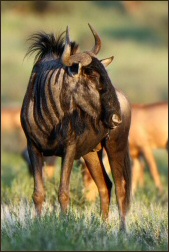Gnu Landscapes
 "Gnu Landscapes," a name that hints at our two main interests - wildebeest, or gnu, and changes in the landscapes they inhabit.
At the core of Gnu Landscapes is the NSF-supported project called "Wildebeest Forage Acquisition in Fragmented Landscapes
Under Variable Climates." In the project, we are studying wildebeest that live in southwestern Kenya. These animals migrate
between areas they live in in different times of the year.
"Gnu Landscapes," a name that hints at our two main interests - wildebeest, or gnu, and changes in the landscapes they inhabit.
At the core of Gnu Landscapes is the NSF-supported project called "Wildebeest Forage Acquisition in Fragmented Landscapes
Under Variable Climates." In the project, we are studying wildebeest that live in southwestern Kenya. These animals migrate
between areas they live in in different times of the year.
The landscapes these migratory animals move through are changing. The rangelands they use are being converted into agricultural areas, fenced to enclose or exclude animals, developed for houses, or turned into roads. This dividing of the land into suitable and unsuitable or inaccessible lands we call 'fragmentation.' The climate of these rangelands is changing as well. Changes in our atmosphere associated with our use of fossil fuels are projected to increase the variability in rainfall from year to year, so that droughts are more severe and more frequent. Some of these projected changes have already been seen. We have studied fragmentation in rangelands for several years, and the effects of drought on migratory animals has been studied. What we are exploring has not been well studied, how fragmentation and drought together affect migratory animals.
We describe our research in greater detail, and the three sites where we work. We review some of the changes in the landscapes in greater detail. Wildebeest biology is briefly reviewed, then we provide information on the specific animals we are tracking. The last three pages describe our outreach and education efforts, project participants, and products we have produced.










